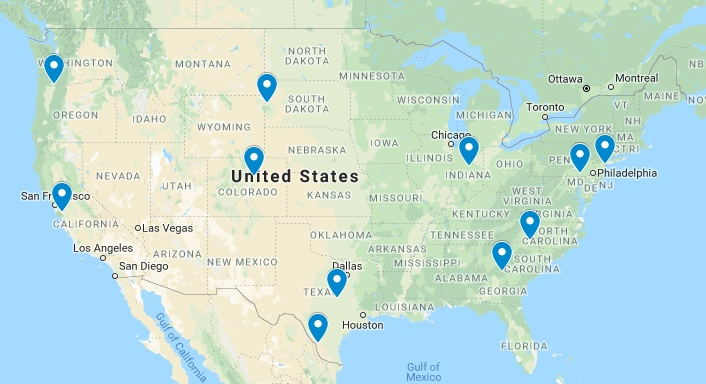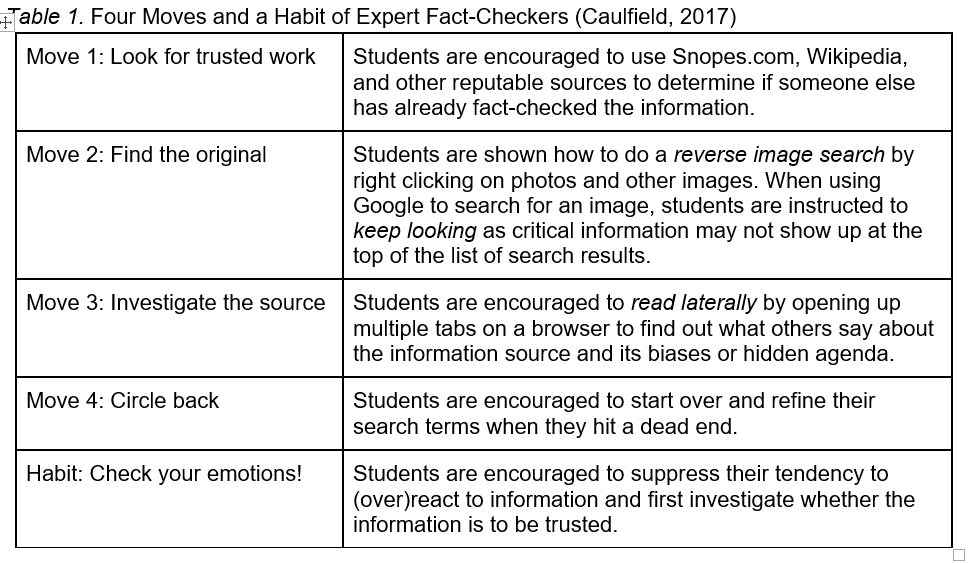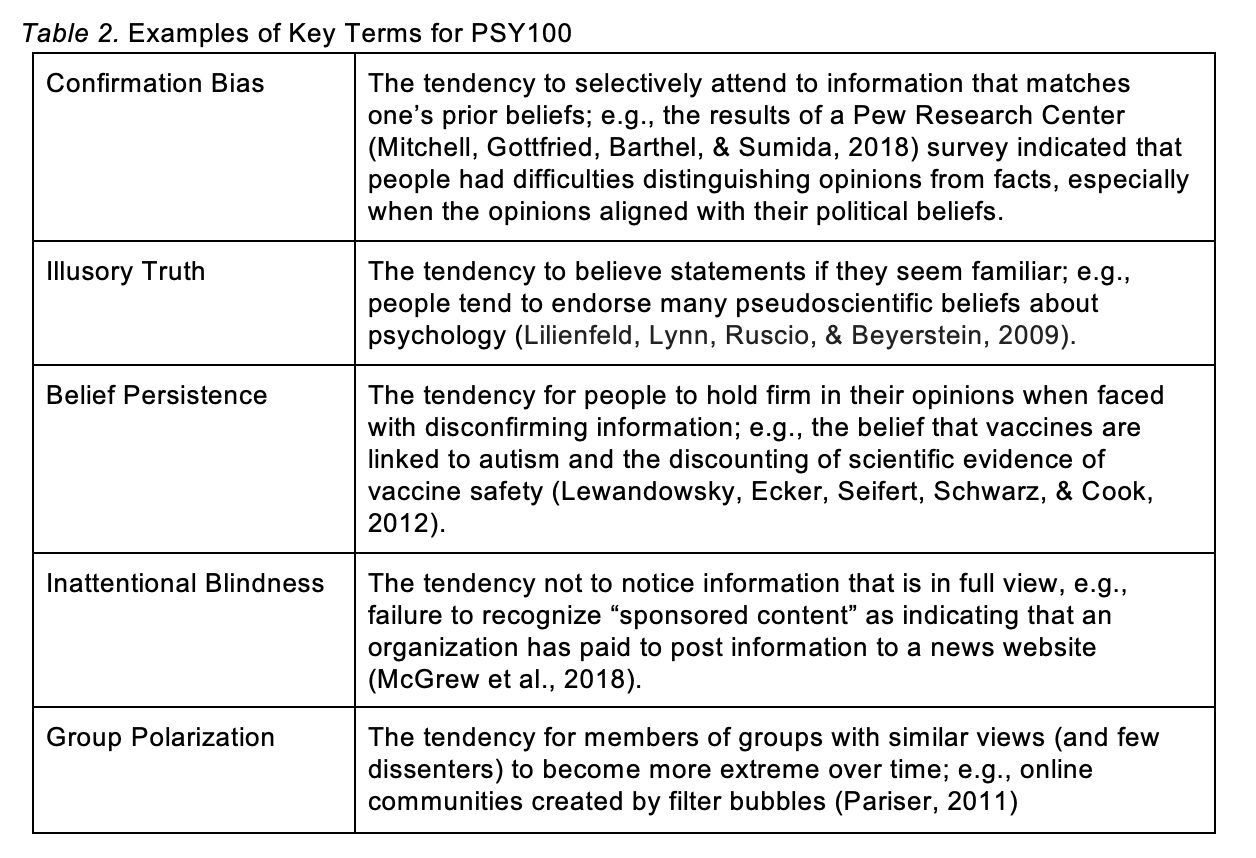By Patricia J. Brooks, Ph.D., and Jessica E. Brodsky, Ph.D. Student, The College of Staten Island and The Graduate Center, CUNY
In today’s media-saturated world, we are likely to encounter false or biased information in our news feeds, as well as images that have been altered or miscaptioned. It is challenging to determine who is behind the information that we consume, and we struggle to distinguish between credible and untrustworthy content (Wineburg & McGrew, 2017).
At the 9th Annual Pedagogy Day Conference recently held at the Graduate Center, CUNY on October 26, 2018, we shared resources from the AASCU’s Digital Polarization Initiative (DPI)—a national effort involving 11 colleges (see Figure 1) that aims to help students develop fact-checking skills and become more critical consumers of online information.

Figure 1. The 11 colleges participating in the AASCU’s Digital Polarization Initiative. (Black Hills State University, CUNY College of Staten Island, Georgia College, Indiana University Kokomo, Metropolitan State University of Denver, Millersville University of Pennsylvania, San Jose State University, Texas A&M International University, Texas A&M University-Central Texas, University of North Carolina Charlotte, Washington State University Vancouver)
The DPI, led by Mike Caulfield of Washington State University Vancouver, builds on the work of the Stanford History Education Group (SHEG), which published an influential study suggesting that students of all ages lack fact-checking skills (McGrew, Breakstone, Ortega, Smith & Wineburg, 2018). The SHEG researchers developed a set of problems (available on their website) to test students’ civic online reasoning abilities, encompassing knowledge of how to determine who is behind information, what evidence supports their claims, and what other sources have to say about the information. They found that, unlike professional fact-checkers, students rarely engaged in lateral reading (see Wineburg & McGrew, 2017) by opening up multiple tabs on their browsers to find out what other trusted sites (such Snopes.com, Wikipedia, or NPR’s fact-check website) have to say about a particular topic or information source.
At the College of Staten Island, CUNY (see far right marker in Figure 1), we are pilot-testing the DPI’s web literacy curriculum in COR100—a required general education course for first-year students. COR100 focuses on contemporary American society and democracy, and its curriculum aligns well with the DPI’s emphasis on building students’ civic, information, and web literacy. In COR100, we teach students the four moves and a habit of expert fact-checkers (see Table 1) through a series of linked online homework assignments and assessments. To develop our assignments, we used online news stories and images from Caulfield’s blog , which he regularly updates with new materials. These examples are free, and you can use them to create lessons in web literacy for your students. More information about the four moves and a habit is also available in Caulfield’s free online book (2017).

We have also begun incorporating these materials into PSY100, where we draw connections between media literacy and critical thinking skills. We use a dual-systems model of thinking (see Kahneman, 2011) to help students develop the habit of checking their emotions (a System 1 reaction) as they learn to investigate online sources of information (a System 2 response). Throughout the semester, our lesson plans build students’ metacognitive awareness of processing biases and shortcuts that influence how we take in information. In our first class, we use illusions to highlight the extent to which our information processing system generates and acts on representations of the world that may be inaccurate (see Table 2). We also contrast System 1 and System 2 thinking using the Cognitive Reflection Test (Frederick, 2005). See below for other examples of key terms that we discuss in relation to information processing and online media consumption.

We encourage instructors, particularly those teaching general education courses, to consider ways that they can teach students to think critically about the online content they consume. The four moves and a habit of expert fact-checkers can be introduced to students across disciplines as efficient and effective strategies for evaluating online news stories and images. Additionally, instructors can also identify opportunities in their courses to develop students’ metacognitive awareness of how their biases and mental shortcuts affect the ways they perceive and interpret information.
References
Caulfield, M. (2017). Web literacy for student fact-checkers… and other people who care about facts. Retrieved from https://webliteracy.pressbooks.com/
Frederick, S. (2005). Cognitive reflection and decision making. Journal of Economic Perspectives, 19(4), 25–42. Retrieved from https://doi.org/10.1257/089533005775196732
Kahneman, D. (2011). Thinking, fast and slow. New York, NY: Farrar, Straus and Giroux.
Lewandowsky, S., Ecker, U. K., Seifert, C. M., Schwarz, N., & Cook, J. (2012). Misinformation and its correction: Continued influence and successful debiasing. Psychological Science in the Public Interest, 13(3), 106–131. https://doi.org/10.1177/1529100612451018.
Lilienfeld, S. O., Lynn, S. J., Ruscio, J., & Beyerstein, B. L. (2009). Fifty great myths of popular psychology: Shattering widespread misconceptions about human behavior. Chichester, UK: Wiley-Blackwell.
McGrew, S., Breakstone, J., Ortega, T., Smith, M., & Wineburg, S. (2018). Can students evaluate online sources? Learning from assessments of civic online reasoning. Theory & Research in Social Education, 46(2), 165–193.
Mitchell, A., Gottfried, J., Barthel, M. & Sumida, N. (2018, June 18). Distinguishing between factual and opinion statements in the news. Pew Research Center. Retrieved from: http://www.journalism.org/2018/06/18/distinguishing-between-factual-and-opinion-statements-in-the-news/
Pariser, E. (2011). The filter bubble: How the new personalized web is changing what we read and how we think. New York, NY: Penguin.
Wineburg, S., & McGrew, S. (2017). Lateral reading: Reading less and learning more when evaluating digital information. Stanford History Education Group Working Paper No. 2017-A1 . Retrieved from: http://doi.org/10.2139/ssrn.3048994
Patricia J. Brooks is Professor of Psychology at the College of Staten Island and the Graduate Center, CUNY and GSTA Faculty Advisor. Brooks was recipient of the 2016 President’s Dolphin Award for Outstanding Teaching at the College of Staten Island, CUNY. Her research interests are in two broad areas: (1) individual differences in language learning, (2) development of effective pedagogy to support diverse learners.
Jessica E. Brodsky is a doctoral student in Educational Psychology at the Graduate Center, CUNY and a member of the GSTA. Her research interests include assessing and fostering media literacy in adolescents and college students, as well as using games to train executive function skills in adolescents.
